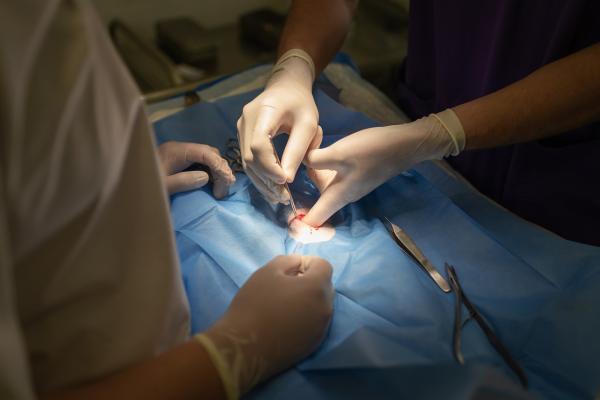
Feline cryptococcosis is the most common systemic fungal disease in cats. However, its infection incidence in the feline population is low, a seeming contradiction we will explain further. Cryptococcus fungi most frequently affect the nasal area, often resulting in an inflamed nose. Swelling of the nose is one of the common symptoms which indicates the cat may have cryptococcosis. However, cryptococcal infections can be found in the lung, eyes, nervous system or present as a systemic infection.
In this AnimalWised article, we explain cryptococcosis in cats. We share what can lead to such a fungal infection, what symptoms to look out for and what treatment options are available. Just as important, we also look at how this disease can best be prevented.
What is feline cryptococcosis?
Feline cryptococcosis is an infectious disease that affects cats and is caused by a type of fungus. Specifically, the most frequently isolated fungal agent is Cryptococcus neoformans. It is a disease associated with habitats where there are birds, especially pigeons, as it is found in their feces. It can also be caused by Cryptococcus gattii, usually in areas of tropical or subtropical climates. In these cases, the source of infection is plant material of certain trees.
It is a small-sized yeast-type of fungus with a worldwide distribution. It has a capsule, which in addition to protecting it from drying out, makes it difficult for the cat's immune system to recognize it. In turn, it triggers the immune response necessary for its elimination.
In cats, a risk factor for the development of C. neoformans cryptococcosis is the presence of immunosuppressive diseases such as feline leukemia or feline immunodeficiency. However, C. gattii infection can occur in individuals without compromise of the immune system. In immunocompromised individuals the infection is usually more severe, while those with a strong immune system the infection is usually localized in the nasal area, without spreading.
What is the pathogenesis of cryptococcosis like?
The main source of infection is inhalation of the yeast, depositing in the upper respiratory system. Here, they produce nasal granulomas, the cause of swelling in the cat's nose. If they reach the lower airways of the lung, they cause pulmonary granulomas.
The fungus can spread to other places, such as the central nervous system via the blood. Lymphatic or local invasion can occur through the cribriform plate of the ethmoid bone that communicates the brain with the nasal cavity. They can also reach other locations, such as the eyes, face and skin. If a severe systemic form of the disease occurs, the yeast can spread to organs such as the spleen, heart, kidneys or digestive organs. it can even infiltrate muscle or lymph nodes.
Symptoms of cryptococcosis in cats
Cryptococcosis can produce very different clinical signs depending on the location of the yeast and the degree to which it spread. There can be several types of cryptococcosis in cats: nasal, pulmonary, nervous, ocular and systemic.
Nasal cryptococcosis
In nasal cryptococcosis in cats, the most common symptoms are respiratory, with upper respiratory tract signs such as:
- Mucopurulent or bloody unilateral/bilateral nasal discharge
- Rhinitis
- Nasal swelling
- Granulomas
- Sneezing
- Respiratory issues
- Pain
- Shortness of breath
Cryptococcus infections are only one reason a cat might have improper discharge from their nose. Our article on why your cat's nose is bleeding will help you understand more.
Pulmonary cryptococcosis
When the yeast affects the lungs, granulomas, fibroblastic foci produced by pneumonia or infiltration around the bronchi can occur. These will produce symptoms related to the lower airways such as:
- Coughing
- Shortness of breath
- Fever
- Lung sounds
Nervous systen cryptococcosis
Cryptococcosis can also reach the nervous system, where signs can be seen that can be a consequence of encephalitis or meningitis due to the presence of yeast in the central nervous system. These symtpoms include:
- Pupillary dilation (mydriasis)
- Changes in gait
- Incoordination
- Indifference
- Total or partial blindness
Ocular cryptococcosis
When yeast targets the eye, it produces:
- Optic nerve neuritis
- Chorioretinitis
- Mydriasis
Systemic cryptococcosis
When cryptococcosis affects different locations, a multitude of symptoms can occur, being the most serious form of the disease. Among them, these symptoms stand out:
- Fever
- Coughing
- Lung condensation
- Anorexia
- Weight loss
- Soft spot
- Ataxia
- Mucosal ulcers
- Lameness
- Vomiting
- Diarrhea
- Cutaneous granulomas
- Inflamed lymph nodes

Diagnosis of cryptococcosis in cats
When the clinical signs suggest cryptococcosis , the cat will be taken to the veterinarian. The clinical history of the animal will be consulted, but diagnosis will require laboratory and complementary tests. These including the isolation and identification of the microorganism by cytology and a culture, as well as the determination of the antigen of the yeast capsule.
- Cytology is performed by puncturing affected areas, such as lymph nodes, growths in the nasal area or skin. Subsequently, it is observed under a microscope with a stain, such as Gram, methylene blue, Wright and India ink, to visualize the organism. It is an organism that is easy to detect due to its characteristic polysaccharide capsule. This will also help differentiate between other diseases such as nasal tumors.
- The culture is carried out from samples of cerebrospinal fluid or exudates from the inflammation. The samples should be incubated in Sabouraud agar medium or blood agar, at a temperature between 25 and 35 ºC/77 and 95 ºF. After 36-72 hours, if positive, bright cream-white colonies will appear. Colonies of C. neoformans have mucous than those of C. gattii. To detect the yeast, the capsule must be visualized and its biochemical characteristics confirmed, such as the ability to reduce nitrates to nitrites and hydrolyze urea.
- To detect capsule antigen, the enzyme-linked immunosorbent assay (ELISA) test is performed with samples of blood serum, cerebrospinal fluid or urine. This test has a high sensitivity and specificity in the cat.
Chest radiography may be useful in the case of pulmonary cryptococcosis to visualize pulmonary and bronchial alterations.

Treatment of feline cryptococcosis
The therapeutic protocol for cryptococcosis includes treatment with antifungal agents to kill yeast and surgical resection of the granulomas. Surgical resection is performed in cats with granulomas in the nasal cavity as an adjunct to medical treatment with antifungal agents.
The antifungals most used for the treatment of feline cryptococcosis are:
- Fluconazole: the antibiotic of choice today because it is the most effective and safe. A dose of 50 mg/12 hours is used orally. It is also effective in case of nerve infections by crossing the blood-brain barrier.
- Itraconazole: similar to fluconazole, itraconazole for cats can be effective. However, it can be toxic to the liver, an important reason why a cat's medical history needs to be consulted.
- Ketoconazole: it is effective in some cases, but not for central nervous system cryptococcosis and can lead to side effects such as loss of appetite and vomiting in cats.
- Amphotericin B with 5-fluorocytosine: a very useful treatment when there are nervous system signs. It was more commonly used in the past.
In any case, it is important to go to the veterinary clinic so that a professional can confirm the disease and establish the best treatment. You should never self-medicate a cat.
This article is purely informative. AnimalWised does not have the authority to prescribe any veterinary treatment or create a diagnosis. We invite you to take your pet to the veterinarian if they are suffering from any condition or pain.
If you want to read similar articles to Cryptococcosis in Cats - Cryptococcus Infection, we recommend you visit our Infectious diseases category.
- Argentine Veterinary Magazine. (2014). Cryptococcosis in felines. Available at: https://www.veterinariargentina.com/revista/2014/02/criptococosis-en-felinos/
- Castellá, G., Abarca, M. L., & Cabañes, F. J. (2008). Cryptococcosis and companion animals. Available at: http://www.reviberoammicol.com/2008-25/S19S24.pdf
- Gines, C., Font, A., Durall, N., Closa, M., & Mascort, J. Feline cryptococcosis, a clinical case. Available at: https://ddd.uab.cat/pub/clivetpeqani/11307064v11n4/11307064v11n4p248.pdf